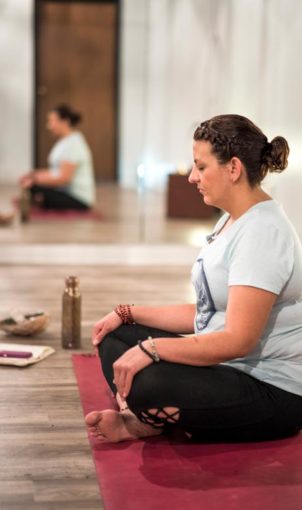Breaking the language barrier with bilingual yoga

Teaching yoga in two languages is tough enough. Ask anyone who has learned Sanskrit. And yet a new yoga teacher in Sioux City, Iowa, has added a third language to the mix. Since June, Carolina Guzman has been leading a class called Vive Yoga at Underground Yoga.
Vive, which means “to live,” is taught in Spanish and English with the usual Sanskrit sayings thrown in — Badhakonasana, Tadasana and Navasana. Between butterfly, mountain and boat poses, Guzman translated everything from English to Spanish throughout the hour-long class.
“Come to a plank. La plancha,” she told her students. “We’ll be here for five breaths. Nos quedamos por cinco respiraciones … Notice your body here. Note su cuerpo aquí.”
Vive started as a Spanish-only class, but Guzman soon made it bilingual to attract more students.
“I felt like, maybe if I open it to bilingual, more people would come, and maybe it would bring people together,” she said. “Because yoga is really for everybody — no matter your language or background.”
Anyone who has ever stepped foot in a yoga studio has probably heard some variation of this saying, “Yoga is for everybody.” However, in the United States, yoga lacks diversity. It’s been well-documented that most practitioners are young, educated, affluent, white women.
Guzman’s bilingual class breaks down a language barrier, but it’s harder to overcome the economic, religious, social and cultural differences. Guzman, who spent part of her childhood in Zapotlanejo, Mexico and speaks English as a second language, is trying to reach out to the Hispanic community and welcome them in. Or at the very least, let people know that a bilingual class exists.
She placed an ad in Mundo Latino, the local Spanish newspaper; posted information about Vive in a Latino Facebook group; and put up flyers at Hispanic grocery stores and restaurants. Despite these efforts, she’s finding that yoga is still met with hesitation and suspicion, which doesn’t make sense to her since curanderos are a part of Hispanic culture. The traditional folk healers use herbal remedies, rituals and spiritual cleansing to treat body, mind and soul — a holistic approach, not unlike yoga.
When she started her yoga practice, some people asked if she was going to become a Buddhist. She had to laugh at this line of logic. She’s a lapsed Catholic but has no plans for conversion, now or ever.
“You don’t have to change your religion, and you’re not joining a cult,” she said.
While she personally enjoys the spiritual side of yoga, she recognizes that some others may feel the need to reconcile the practice with their religion, and she respects that.
To make Vive more inclusive, she leaves out the chanting, the mantras, the overly spiritual intentions and the stories from Hindu mythology. In one of her classes, she set an intention “to connect with our breath and to move with our breath.” And she left it at that.
With yoga, Guzman didn’t have religious qualms to overcome. Instead, her hang-up was thinking, “I need to know yoga to do yoga.” So she started her practice with videos at home, seeking stress-relief and relaxation. Eventually, she took her mat to a class and discovered a warm, welcoming community. Even though she was often the only Hispanic person in the room, she never felt like she didn’t belong.
In fact, she loved it so much that she signed up for yoga teacher training last fall. She didn’t intend to teach — at least not right away, maybe someday. But then the owner of Underground Yoga contacted her with an opportunity to teach chair yoga and a Spanish-language class.
“I found myself saying, ‘Yes.’ And I was like, what did I just say? I felt that this was very challenging — way out of my comfort zone,” she said. “But this is something you just have to share.”
Ally Karsyn is the founder, producer and host of Ode, a live storytelling series presented by Siouxland Public Media, the NPR affiliate in Sioux City, where she is the arts and culture producer. This article was originally published in YogaIowa’s Fall 2017 issue.


